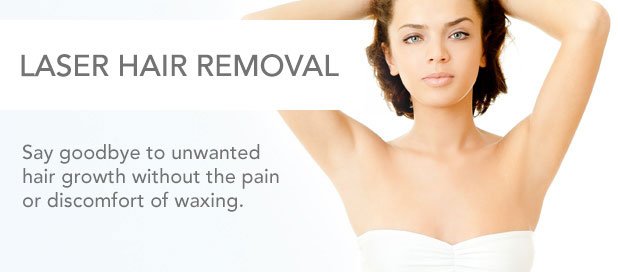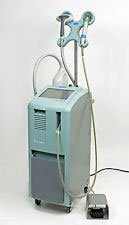
Unwanted facial and body hair is bothersome to many patients during the year, but is especially noticeable in the summer, when we trade in wool sweaters for beach wear. We offer laser hair removal, and can treat hair from most parts of the body, including the face, legs, arms, underarms, back, chest, nipples, and bikini lines.
Laser hair treatment is performed with our Cutera Xeo Yag laser. The skin is covered with a clear, cool, water-based ultrasound gel, which helps to protect the skin. The laser beam is aimed at the hair, and the pulse of laser emitted is controlled by a foot pedal. An internal cooling tip in the wand is held against the skin, which helps with patient comfort. Laser energy is pulsed over the hair, and travels down the hair shaft to reach the follicle, or base of the hair. The energy damages the follicle, and the damaged follicle then produces a lighter, finer hair. The existing hair “plumes,” which is a visible sign that the hair has responded to the laser, and will fall out over time. The “new” hair growth 
Frequently Asked Questions
Should I shave prior to my laser hair treatment?
A small amount of stubble is recommended for optimum laser treatment. We recommend shaving the area to be treated, and then allowing stubble to grow to 1-2mm length for treatment. Doing so allows us to visualize the “plume” effect, to know that hair has been treated successfully. There are acceptable ranges for laser energy, and we use the lowest energy that will allow us to successfully treat hair. If hair does not “plume,” we gradually increase the laser energy being used. If hair has been shaved, there is nothing to plume, and it is difficult to be assured that the laser energy has been absorbed. Longer hair absorbs more energy, so unshaved, lengthy hair absorbs more energy and creates more heat within the skin, contributing to discomfort. After treatment, hair can be shaved. The laser energy absorbed in the hair is immediate, and shaving the plumed hair will not un-do the benefit of laser treatment.
What do the treatments feel like?
Cutera systems are especially designed to cool and soothe as they glide along your skin. When the pulse of light is delivered, some patients experience a mild pinching or stinging sensation. No local anesthesia or pain medication is required.
How many treatments will I need?
Most areas require 4-6 treatments. However, the number of treatments required for optimal long-term benefits depends on multiple factors – hair thickness, the area treated, and your hair’s growth cycle. Not all hairs are actively growing at the same time and go through three phases: growth, regression, and resting. Laser treatments work by disabling the hair that is in the active growth phase at the time of treatment. Since other hairs will enter this active growth phase at different times, additional treatments may be necessary to disable all of the hair follicles in a given area.
What happens after the treatment?
Immediately following your treatment, the area may appear a bit red and swollen. Three to seven days after treatment you may experience what seems to be regrowth of hair. Actually, most of these hairs are being shed as a result of your treatment and are not regrowing. Between treatments, you should not wax or pluck your hair, but it is permissible to shave. (Plucking or waxing removes the entire hair shaft, which removes the vehicle for the laser to work).
Are there any restrictions on my activity after treatment?
Following the treatment, you can return to your normal activities right away, but some redness may occur. The use of sunscreen is recommended on any treated areas exposed to the sun. Ideally, patients will avoid sun exposure to the treated area for a few days.
What are the possible side effects?
Although patients experience few side effects, the most commonly noticed are slight reddening and local swelling of the skin similar to a sunburn. These effects typically last for several hours or less. In rare instances, blistering may occur.
How do Cutera hair removal treatments compare with other hair removal methods?
Shaving, waxing, and depilatory creams are all temporary methods which must be repeated on a frequent basis. Treatment with Cutera systems provides permanent hair reduction for lasting results.
How does it compare with electrolysis?
Electrolysis is a tedious, invasive, and painful process that involves inserting a needle into each individual hair follicle and delivering an electrical charge to them one at a time. Electrolysis often requires years of treatments at regular intervals. By delivering light energy to hundreds of hair follicles at one time, the Cutera laser effectively treats an area in just seconds that would take over an hour with electrolysis.
Why choose hair removal with our Cutera system over other laser hair removal solutions?
Using the latest technology in laser hair removal, the Cutera laser can rapidly treat large areas without the limitations of older technologies. Cutera’s systems use longer wavelengths allowing them to be used safely and effectively on patients with light or dark skin. Unlike other systems, it can treat the fine hair on a woman’s upper lip just as easily and effectively as the coarse hair on a man’s back. The cooled handpiece increases patient comfort and minimizes the adverse skin reaction commonly seen with other lasers.
Cutera, Inc. (2014, October). Hair Removal: Cutera Hair Removal Solutions. [brochure]. Brisbane, CA.

